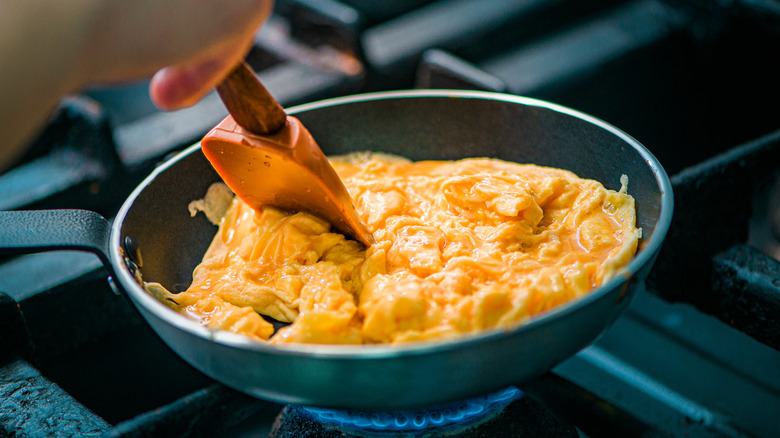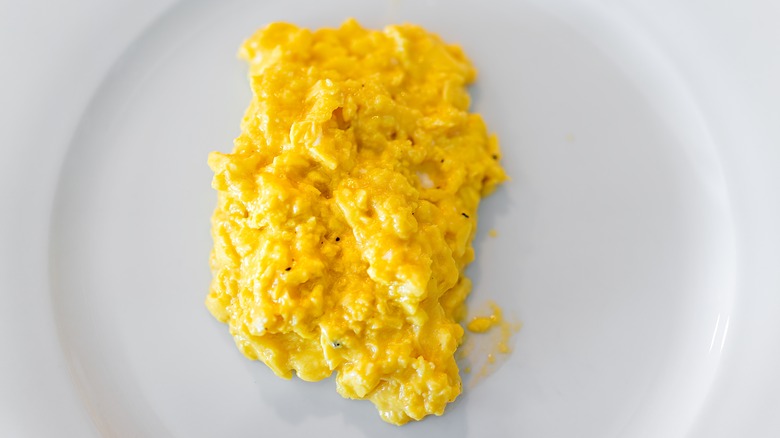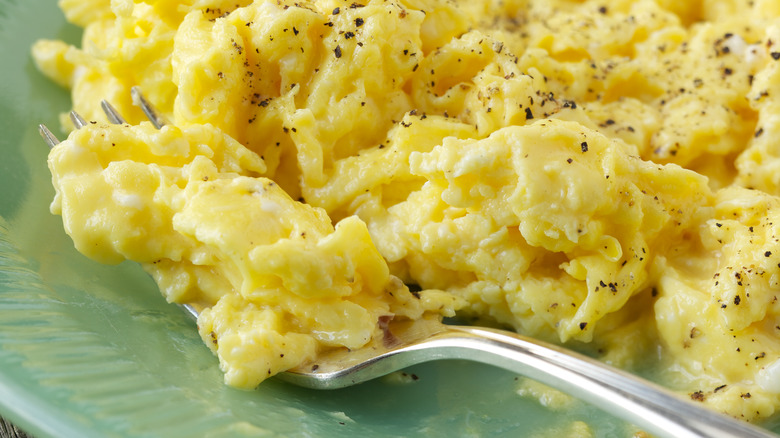The Spatula Maneuver For Small Vs. Large Curd Scrambled Eggs
For something as simple and unpretentious as scrambled eggs, there are an awful lot of tips, tricks, and methods out there to help you produce the "best" kind. From the type of pan that's best to the addition of mayonnaise for creamy results, chefs, foodies, and writers all toss in their two cents as to what creates the ideal breakfast staple. But, really, what makes the most delicious scrambled eggs all comes down to personal preference and it usually begins with the curds.
The curds are the cooked pieces of scrambled egg and they can be large (big and fluffy) or small (wet-looking). Both types have devoted fans with most scrambled eggs served in American diners and restaurants (and home kitchens for that matter) falling into the large category. For achieving perfection in either type, it's all about the way you mix the eggs in the pan with your spatula. Of course, the type of pan you use (nonstick is best) and the heat level (not too hot) can make or break any type of egg, but if you can figure those out, you'll see that larger swirls of your spatula will produce larger curds while short, swift ones will give those silky small pieces.
Quick stirs will give you small curds
Small curd scrambled eggs are often referred to as French-style scrambled eggs because this is how they're preferred in the land of perfect omelets. Once properly cooked and finished, this type of scrambled egg looks, honestly, pretty underdone. The eggs are very moist with a custard-like appearance and texture, but this is what people love about them. They're often served on top of buttered toast for a nice textural contrast.
To begin, the eggs should be scrambled separately in a bowl; don't crack the eggs directly into the pan. Once you pour the eggs into the buttered pan, take your silicone spatula and mix the eggs in quick, small, circular motions. This gets the eggs moving and doesn't give them time to fully set on the bottom of the pan. Keep this rapid stirring up until the eggs take on a custardy appearance. If you want super-small, mousse-like eggs, use a silicone whisk instead of a spatula. As simple as they are, French-style scrambled eggs are considered elegant and a testament to the chef's excellent cooking skills. They are often served showered with fresh soft herbs like chives and parsley.
Larger, sweeping motions produce the best large curds
Scrambled eggs with larger curds does not mean dry, overcooked, rubbery eggs. Unfortunately, this is what often happens when the eggs are cooked over heat that's too hot, or if the eggs are not stirred in the pan. The pan and heat level are just as important in creating large curd or American-style eggs. These eggs should be pillowy, fluffy, and tender when they are cooked correctly but not so creamy as French-style.
Again, the eggs should be pre-scrambled and poured into a pan with butter or oil and should be mixed nearly constantly. But instead of rapid, circular stirs, take your silicone spatula and use larger motions, moving the egg from the outside of the pan towards the middle. It should almost feel like you're folding in ingredients like you'd do in baking. You'll know the eggs are done based on how they look and if there are no signs of raw, uncooked egg in the pan.
Contrary to popular opinion, perfect scrambled eggs of all forms should not be ready in just a couple of minutes. Ideally, you'll heat the pan over medium heat but then lower the heat to medium-low once the eggs go in. The low heat cooks the eggs slowly, allowing you to better monitor the doneness and to better achieve the ideal texture you're going for, and perfect scrambled eggs are always worth the wait.



